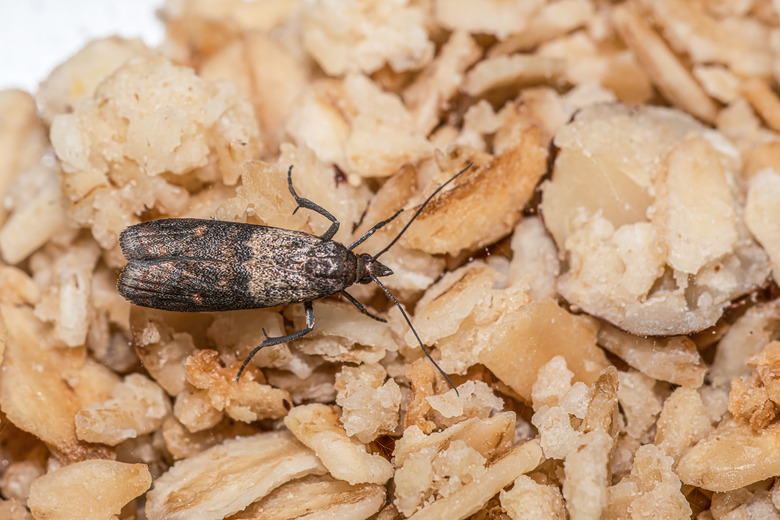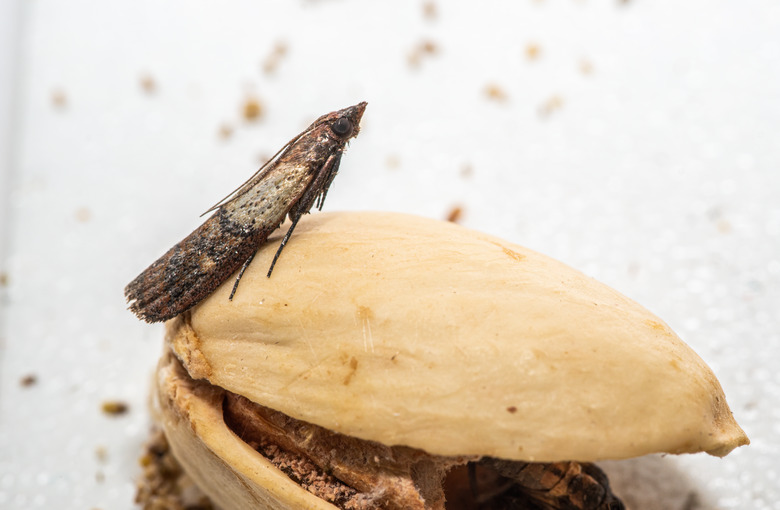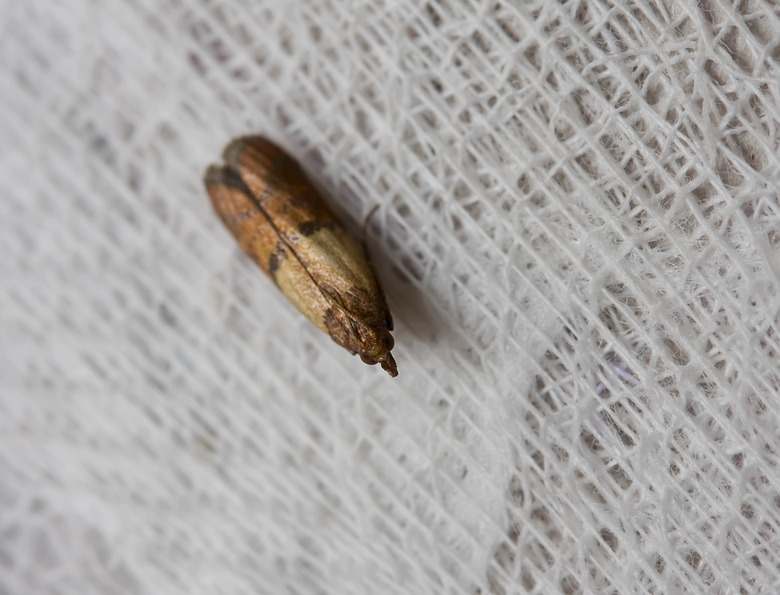How To Get Rid Of Pantry Moths
We may receive a commission on purchases made from links.
The moths you've seen flying around your kitchen are the grown-up versions of the little white worms you found in your flour. If you spot these pests swarming around your pantry, you'll unfortunately to learn how to get rid of pantry moths. Their larvae infest and ruin stored grain products, covering them with a silky, loose webbing. Prevention and control of pantry moth infestations primarily involves cleaning (and cleaning some more).
What Do Pantry Moths Look Like?
What Do Pantry Moths Look Like?
- Species name: Plodia interpunctella, commonly known as pantry moths or Indian meal moths.
- Physical characteristics: Adult pantry moths measure about 1/2 inch in length
and have a wing span of around 5/8 inch. Their two-toned wings
that fold over their backs are gray toward the front and then a coppery-rust color
marked with black. The thorax and head are gray, and the posterior is brown. - Wings or wingless? Wings
- Life cycle and appearance:
The entire life cycle of the pantry moth can run from 27 to 305 days.
The moths mate and lay eggs about three days after adult emergence, with a female laying up to 400 eggs. Depending on temperatures, the eggs hatch in three to four or seven to eight days. After hatching, the pantry moth larvae scatter to settle in the food source where they develop for six to eight weeks. The pupal stage, which is temperature-determined, lasts from seven to eight or from 15 to 20 days.
Pantry moth eggs, found singly or in clusters, are a
grayish-white color and measure from 0.3 to 0.5 millimeters. The color of the pantry
moth larvae depends on the food source. Most commonly off-white, they can also
be brown, pink, or almost green. The adult larvae measure 1/2 inch and
have five pairs of legs. A pupating larvae, at 1/4 to 2/5 inch, is either unprotected or in a silken cocoon and is a light brown color.
- How to tell apart from lookalikes: Pantry moths are
often thought to be clothes moths, especially when they're seen fluttering into
bedrooms and other areas where closets are located. There are two types of clothes moths, and both are smaller than pantry moths (about 1/4 inch long). Clothes moths are not strong fliers and tend to stay near clothes. They aren't likely to be in your kitchen or food pantry.
How To Get Rid of Pantry Moths
Empty Your Pantry
When trying to get rid of pantry moths, the first defense is to throw away any infested food immediately — even if you just bought it from the store. If you keep your trash in the garage before pickup day, be sure to place the infested package inside a glass or hard plastic container with a secure lid or top.
If you didn't find the pests in something just purchased, you'll need to take everything out of your pantry and cabinets, and that means everything. Pantry moth larvae can take up residence in cardboard boxes, waxed paper, and plastic wrapping within the same cabinet. Adult moths will even lay their hard-to-see eggs under jar lids.
When you're going through your pantry, be sure to also throw out anything that isn't in an airtight container. If you still feel concerned about an item you want to keep that seems undamaged, place it in the oven at 130 degrees Fahrenheit for one hour or in the freezer for one to two weeks to kill any eggs that are present.
Clean Everything — No Exceptions
Remove all shelf liners in your pantry and toss them. If your shelves are removable, take them out for cleaning. Use a crevice attachment with your vacuum to clean out every corner, edge, crack, or hole in your pantry and cabinets, including peg holes for adjustable shelves.
Next, wash everything. Use hot, soapy water to wash all unopened cans and jars and scrub under the jar lids with a brush. Wash all surfaces inside your cabinets and pantry with soap and warm water, including the underside of shelves. Don't reach and clean without looking. Climb onto a stepladder so you can eyeball what you're cleaning, focusing on removing any food that has spilled and any cocoons. If you have peg holes, dig into them with a toothpick.
Give It Time
If you have a bad pantry moth infestation, you may have to wait up to six months to stop seeing moths and larvae. Although it may be difficult, don't restock your pantry before they're completely gone. Find other places to securely store what you'll need while riding the infestation out. If it wasn't extensive, wait a few weeks before restocking. Repeat all of the cleaning steps if you're still noticing moths or larvae.
Get Pesticide-Smart
Much of what can be done to get rid of pantry moths involves taking a natural, sanitation-related approach. Many green-leaning homeowners are opposed to using insecticides in areas where food will be stored or prepared. But, insecticides can admittedly reach areas difficult to access for cleaning and can help knock down a serious infestation quicker. If you're comfortable using such products in these areas of your home, do so only when the infestation is bad, and basic sanitation measures aren't solving the problem. If you choose to go the pesticide route, use products that are designated safe for kitchen use.
Keep in mind that you should never spray food, food-preparation utensils, eating utensils, or dishes with pesticides. Before spraying, remove all such items in addition to storage containers and shelf lining paper. Most products are sprayed into crevices and voids around drawers, cabinets, and pantries. Make sure the spray is dry before replacing what was removed.
How Pantry Moths Get In Your House
How Pantry Moths Get In Your House
How pantry moth larvae appear in your sealed food containers may seem like a mystery, but the fact is that the eggs were no doubt already there when you brought the food home from the store. Pantry moth eggs and larvae can normally be traced to food packaging facilities and to bulk bins of natural food stores.
Pantry moth infestations in your home are not a seasonal problem. If your house is warm in the winter, that's all they need for the progress of their life cycle and for breeding.
How To Prevent Pantry Moths
How To Prevent Pantry Moths
To prevent pantry moth problems, regularly check your stored dry goods, especially those items you've just brought in and those you've kept longer than two to four months. Pantry moths infest cereals and grains, meal and flour, pasta, dried herbs, spices, dried fruit, candy, nuts, powdered milk, and especially bird seed and dry pet foods. Make an effort to use your older dry foods first and all dry foods within two to four months.
Store anything that's kept longer in airtight jar, such as spices. And, it's a good idea to just be diligent in general about all food storage practices. Store dry food items in airtight glass or plastic storage containers and canisters. Transfer any dry food products from plastic bags into these containers. Pantry moth larvae can chew through plastic bags to access a food source.
Pay particular attention to your storage methods for pet food. Dog food, cat food, and bird seed are the most frequently infested items. Store these dry foods in a well-sealed, airtight container, such as a Vittles Vault. Keep small quantities of cooking spices in bags in the refrigerator or freezer. As tempting as it can be to save money on larger quantities, especially when discounted, resist the urge to overbuy, opting instead for package sizes that you can use in a more reasonable amount of time, and wash the containers between refills.
Decrease the male moth population by using moth pheromone traps that attract the males to a glue board, ensuring they won't mate with female pantry moths. You can also try sprinkling diatomaceous earth in the corners and on the edges of the shelves in your cabinets and food storage areas.
Make a habit of inspecting your pantry and cabinets regularly for cleanliness, immediately wiping up any spilled food you see. Clean beneath shelf paper, vacuum, and caulk cracks to eliminate places into which dried food can get wedged. Toss all old packages of dried food or any that show damage. Additionally, because you can unfortunately bring pantry moths home with you from the grocery store, you should also inspect store items for damage. If you notice holes or tears in packaging, don't buy it.
Additionally, to prevent pantry moths from infesting your kitchen, you should learn how to detect their presence elsewhere in your house. An adult moth flying around that fits the pantry moth color description is a strong indication that you have an infestation somewhere. Also be on the lookout for larvae. After developing in the food source, they often crawl into other cabinets, onto walls, and up into ceiling corners to find dark spots where they can spin their webs and pupate. The problem is unlikely to be confined to the contaminated dry food, and an undetected larva hanging around the house is simply a guarantee of future infestations. The moth that it becomes will lay eggs, and you'll have to deal with the problem all over again.
Do Pantry Moths Cause Damage or Spread Disease?
Do Pantry Moths Cause
Damage or Spread Disease?
Pantry moths may be troublesome, but they don't spread disease. In fact, unpleasant as the thought may be, unwittingly eating them at any stage causes no harm to either humans or pets. Damage, on the other hand, is another matter. These pantry pests can wreck what you've stored in your kitchen by spinning over the dry foods excessive quantities of silk that eventually hold deposited fecal pellets, cast-off skins, and egg shells. In addition to losing possibly large quantities of food and spending money on replacement, the result is that you have no choice but to undertake what can be an extensive, inconvenient, and time-consuming cleanup process.
References
- University of Florida Entomology and Nematology Department: Featured Creatures, Indianmeal moth
- Texas A&M AgriLife Extension: Indian Meal Moth
- National Pesticide Information Center: Pantry Moths
- Texas A&M University: Extension Entomology: Indian Meal Moth
- The Old Farmer's Almanac: How To Get Rid of Pantry Moths and Worms
- Today's Homeowner: How To Get Rid of Pantry Moths and Larvae in Your Kitchen
- Moth Prevention: How To Get Rid of Pantry Moths Naturally — 10 Steps To Pantry Moth Control




